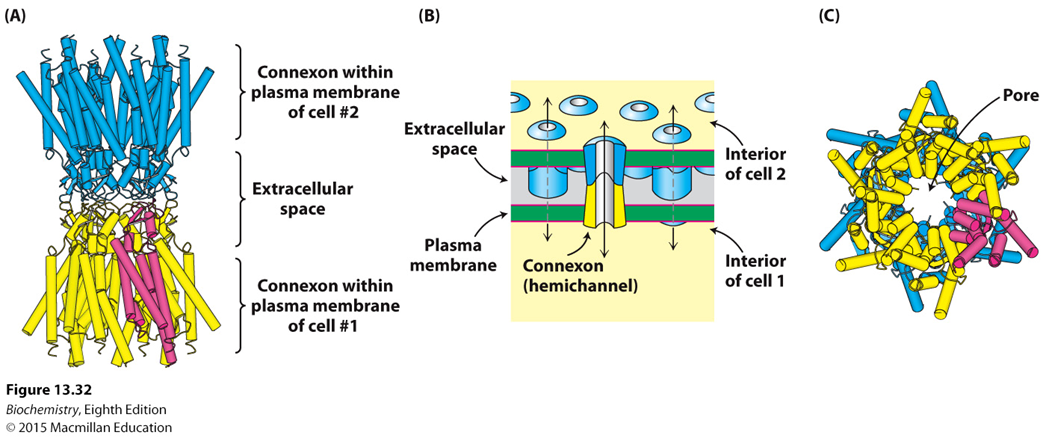BioChem Exam 3 Content
1/32
There's no tags or description
Looks like no tags are added yet.
Name | Mastery | Learn | Test | Matching | Spaced |
|---|
No study sessions yet.
33 Terms
What is the structure of a fatty acid?
How many number of carbons are present in fatty acids (even/odd)?
What does the position of the double decide?
Hydrocarbon (just C’s and H’s) with a carboxylic acid at the end

Even number of carbons, usually 16 to 18 carbon atom chains
(Note: The methyl carbon atom on the far right end of the structure is called the omega carbon)
The number of what type of Omega fatty acid it is (Omega-3, Omega-6, Omega-9)
What is the structure of a fat molecule?
What is this structure linked together by?
A glycerol backbone with three fatty acid tails
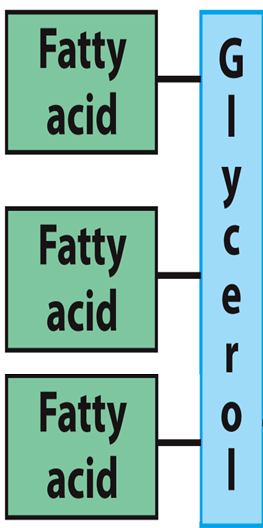
Ester linkages
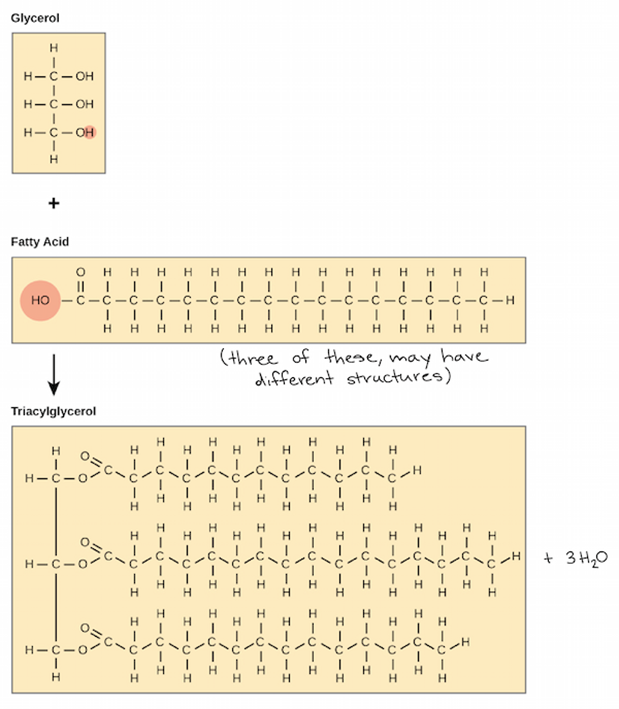
(Note: Ester linkages change the carboxylic acid group into ester group with a by-product of 3 water molecules)
What is the structure that increase the risk of heart disease and stroke, including obesity and metabolic syndrome?
Triglycerides
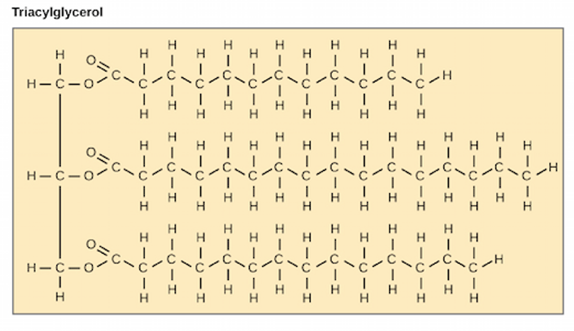
(Note: TGs are super hydrophobic)
What are the four total component of a phospholipid?
What are the two common platforms for phospholipids?
Fatty acids (1 or more), a platform, a phosphate, and an alcohol
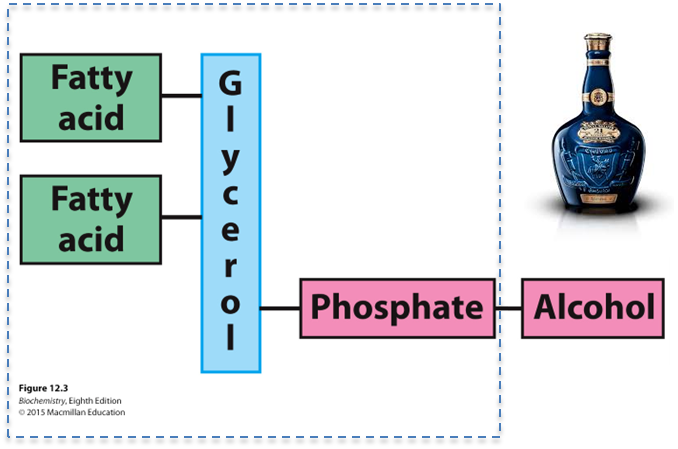
Glycerol and sphingosine
What is the structure of a phosphatidate?
What is phosphatidate (PA) a precursor for?
A glycerol backbone, fatty acids on carbons 1 and 2, and a phosphate on carbon 3
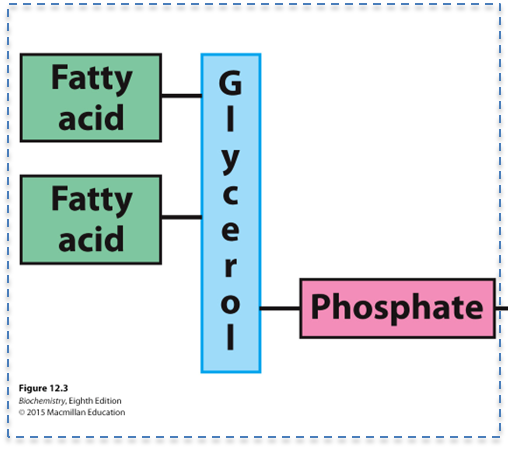
The biosynthesis of many other lipids
What are the four common features of the biological membrane?
Membranes are sheetlike, only two molecules thick and forms closed boundaries between different compartments
Membranes composed of lipids and proteins/peptides can be decorated with carbohydrates
Non-covalent assemblies (IMPORTANT!)
Asymmetric (IMPORTANT!)
How is the membrane asymmetric?
The outer surface (hydrophilic heads) are different from the inner surface (hydrophobic tail)
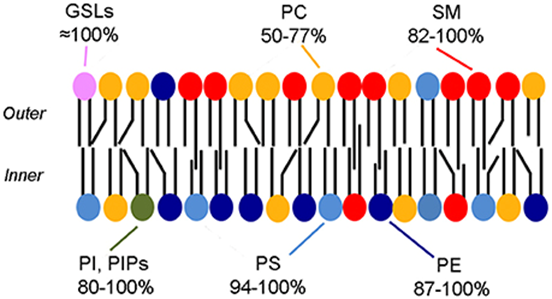
(Note: The different shapes of the black lines, which are the hydrophobic tails)
What is apoptosis?
Programmed cell death (peaceful cell death)
Where is phosphatidylserine (PS) kept in?
Where can PS be exposed?
What is implied by the “eat me” signal?
The inner membrane (the side facing the cytoplasm) in healthy cells
At the cell-surface of dying, mutated, cancerous, or microbe-infected cells

PS exposure serves as an “eat me” signal so macrophages can hunt it out (only exposed in bad cells)
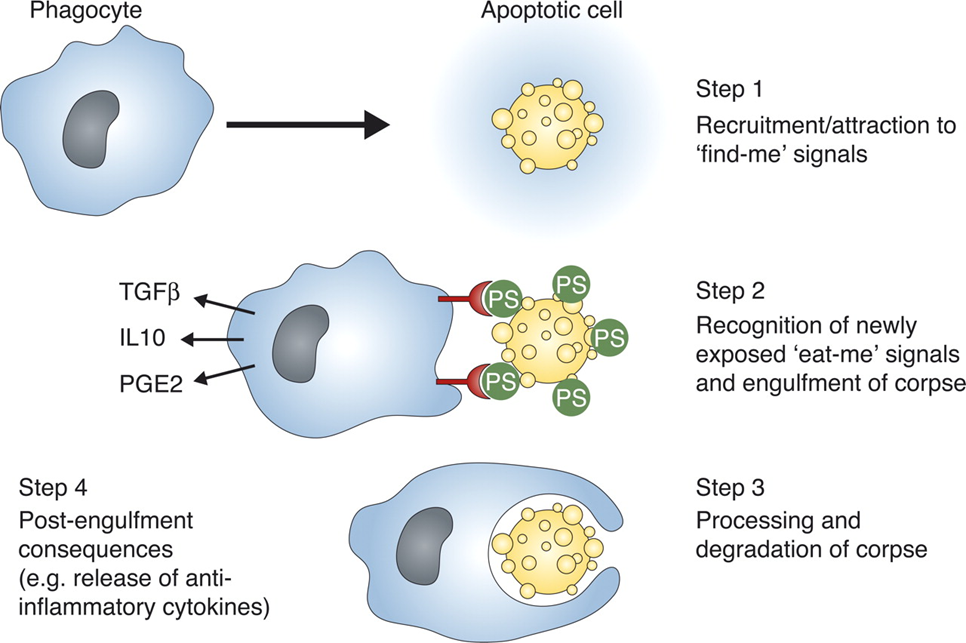
What is the structure of a sphingolipid?
What are glycosphingolipids?
Where are they located and what are they responsible for?
Sphingosine, an amino alcohol that contains a long, unsaturated hydrocarbon chain

(Note: Instead of a glycerol backbone)
A sub-group of glycolipids based on sphingolipids
In nervous tissue and responsible for cell signalling
What are glycolipids?
Where are they found?
What is its function?
Lipids with carbohydrates (sugar containing lipids) that are attached with a covalent glycosidic bond
On the surface of all eukaryotic cell membranes, where they extend from the phopholipid bilayer into the extracellular environment
Cell to cell communication and immune response
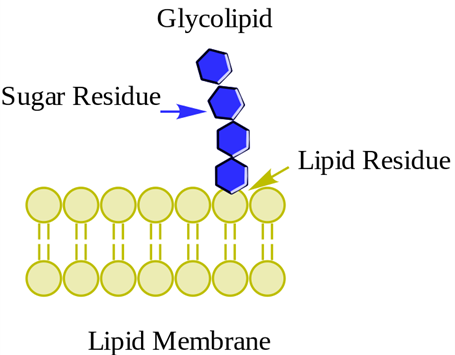
What is the simplest glycolipid?
What is the structure?
Cerebroside
A single sugar residue, either glucose or galactose

What is cholesterol?
What group in the cholesterol structure interacts with phospholipid head group?
A steroid that is modified on one end by the attachment of a fatty acid chain and at the other end is a hydroxyl group
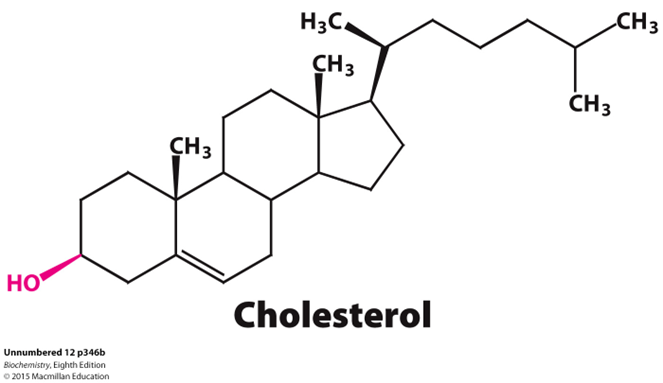
(Note: The pink HO group is the hydroxyl group, the right side is the fatty acid chain)
The hydroxyl group
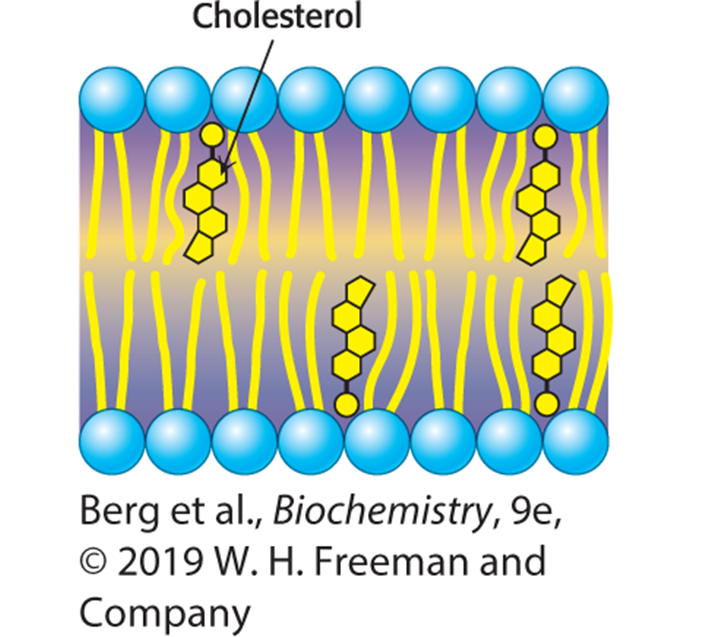
What type of regulation does cholesterol provide and for what?
What does cholesterol do when the membrane is too rigid?
What does cholesterol do when the membrane is too molten?
Bidirectional regulator of membrane fluidity
Inserting itself in between the membrane to separate them more
Raises the melting point to withstand the heat and inserts itself in between the membrane and somehow holds them together
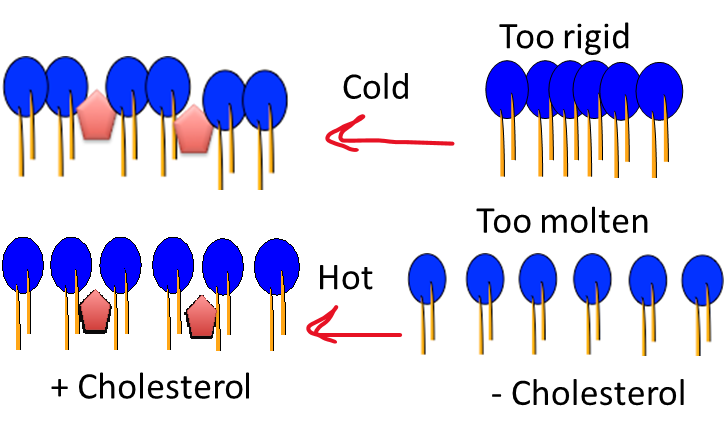
What does cholesterol form complexes with (3 things)?
What are lipid rafts? What can they function in?
Why do many pathogens use lipid rafts?
Sphingolipids, glycolipids, and some GPI-anchored proteins
A “door” to acknowledge the signal and send the signal to go to further pathways, not letting it in. Functions in signal transduction
As a portal to enter cells because they contain structures that the substrate recognizes (“lock and key”)
Where is cardiolipin most often found?
What is the enzyme required for the proper synthesis and maintenance of cardiolipin?
What is barth syndrome?
In the membranes of bacteria, archea, and the inner membranes of mitochondria
Tafazzin
Mutations that reduce the catalytic activity of tafazzin. Symptoms include dilation of the heart chambers, exercise intolerance, and impaired growth
How are membranes made permeable to the lipid bilayer (3 things)?
What are ion channels?
Why do pumps use ATP for active transport? Give two examples of ATP-driven transporters.
Channels, carriers, and pumps
Pore-forming membrane proteins
To transport substrates against the concentration gradient (low —> high). P type ATPases and ABC (ATP-binding cassette) transporters
What kind of molecules can pass membranes down the concentration gradient through simple diffusion (high —> low)?
What kind of molecules require the presence of a channel to move across a membrane down their concentration gradient through facilitated diffusion/passive transport?
Lipophilic (lipid-loving, hydrophobic)
Charged or highly polar molecules (ex: Na+)
What determines the direction in which steroid hormones can move through a membrane?
List two other examples that can (pass through a membrane)?
SABRINA! Not sure how to word this question, what “other example” is this in reference to?
Concentration gradients
CO2, O2
What does the N domain serve as in a P type ATPase pump mechanism?
What does the P domain serve as in a P type ATPase pump mechanism?
What does the A domain serve as in a P type ATPase pump mechanism?
Built-in protein kinase that functions to phosphorylate the P domain (add phosphate)
Contains aspartic acid (D) residue which gets phosphorylated during the reaction cycle
Built-in protein phosphatase that functions to dephosphorylate the phosphorylated P domain (take away phosphate)
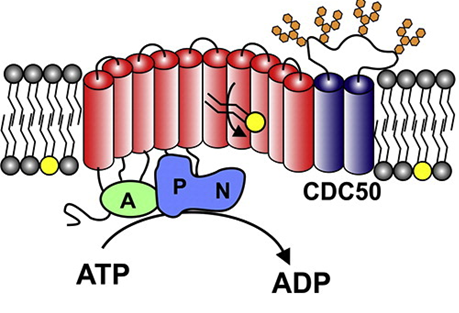
What two conformations do pumps must exist in?
What powers the interconversion of the two conformations?
One with the ion binding site facing into the cell and one with the binding site facing out of the cell
ATP hydrolysis
List the six steps of the catalytic/transport cycle of all pumps.
Calcium binds to the pump
ATP binds to the N domain
Phosphate binds to the P domain
ADP is released and a structural change occurs so that the calcium binding site now faces the sarcoplasmic reticulum lumen (outside) and the calcium leaves the enzyme
Phosphate in the P domain is hydrolized (taken out)
The enzyme changes conformation so that the calcium binding site again faces the cytoplasm (inside) (starts the process over again)
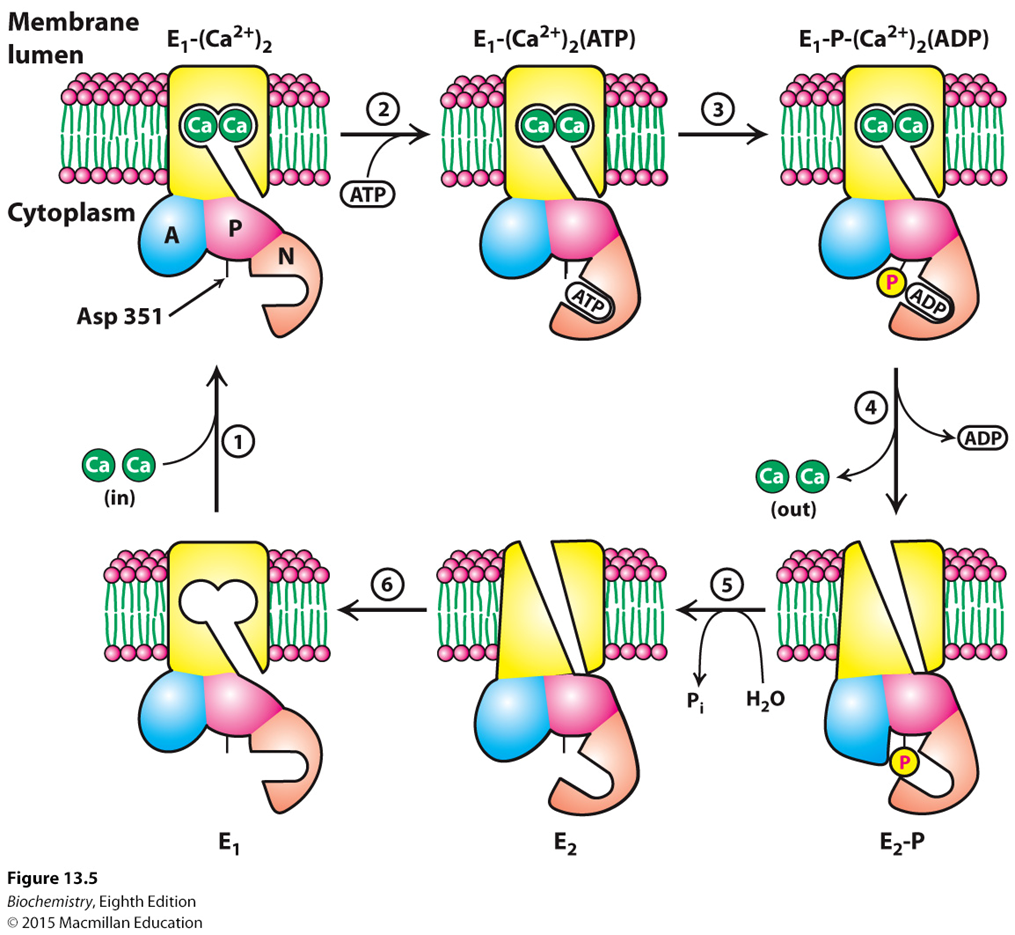
(Note: The outside is the membrane lumen and the inside is the cytoplasm)
What type of steroid is used to treat congestive heart failure?
What does this steroid do?
Where can this steroid be found?
Cardiotonic steroids
Inhibit sodium potassium ATPase by blocking the sodium potassium pump’s ability to dephosphorylate, increasing the calcium in the body for better contracting of the heart
Foxglove flower (Digitalis purpurea)
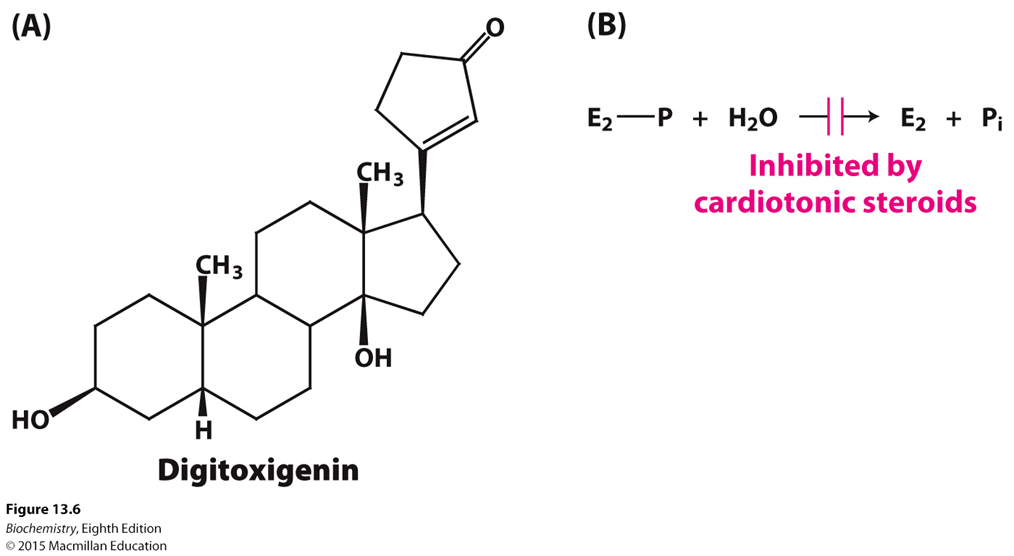
(Note: Digitoxigenin is an example of the cardiotonic steroid that inhibits dephosphorylation)
List the four steps that results when the sodium/potassium pump gets blocked or stops working.
Sodium/Potassium pump stops working/blocked, resulting in excess Na+ inside of the cell
Sodium/Calcium pump stops working, resulting in excess calcium inside of the cell
SER-CA moves the excess calcium into the ER
Muscle contraction
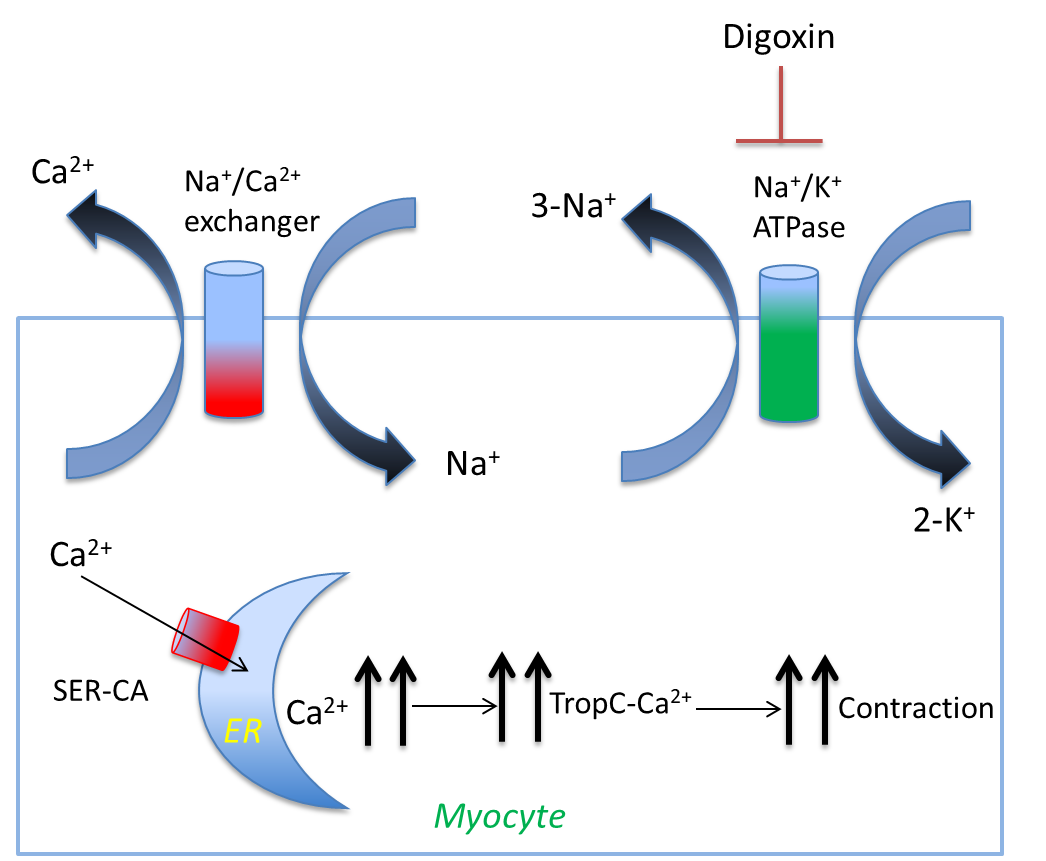
How many known ABC transporters are present in humans?
How many families can these ABC transports be split up in?
What domains do the ABC transporters have and how many of each do they have?
49
7 (ABC A-G)
Two ABC domains and two membrane-spanning domains
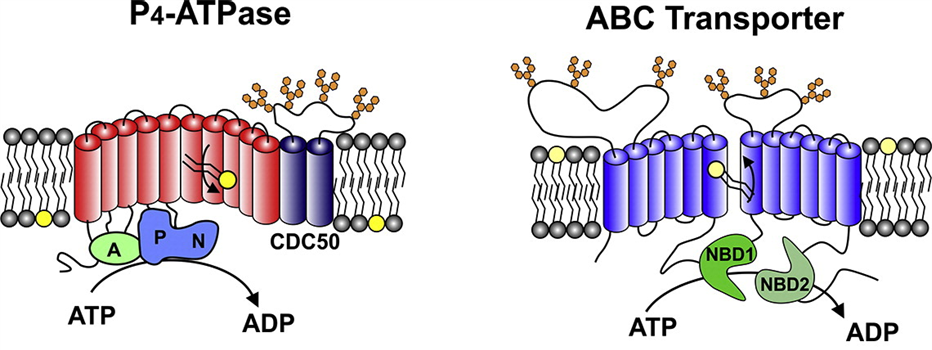
(Note: Pay attention to only the ABC transporter on the right)
What is a multidrug-resistance protein pump?
SABRINA! Help understnand a little more?
An ATP-dependent pump that extrudes small molecules from the cell and is a member of a family of transporters called ABC transporters
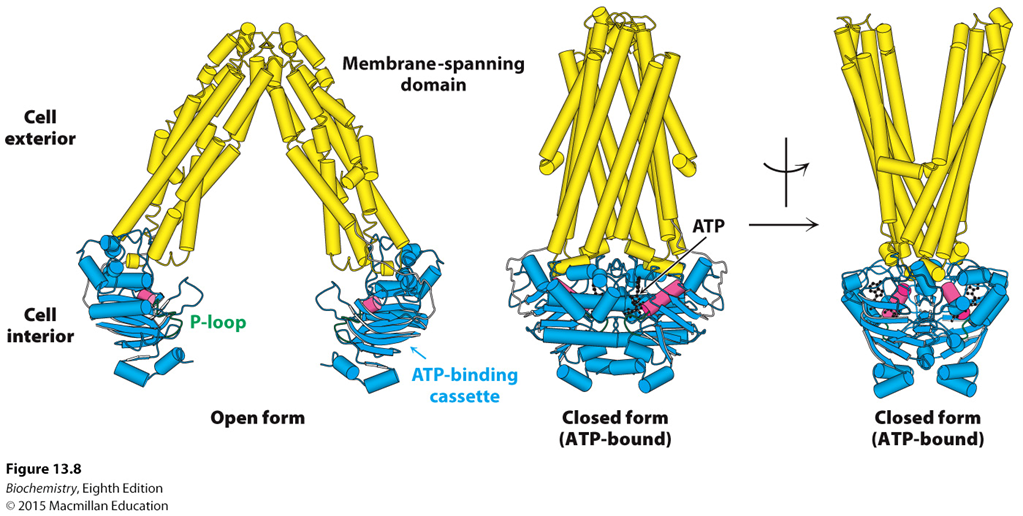
List the five steps of the reaction cycle of the multidrug-resistance pump.
List the two names of the multidrug resistance microbes.
The channel is open to the cytoplasm
Substrates bind, causing conformational changes in the ABC domain
ATP binds to the ABC domains, causing more structural changes that orient the substrate so that it is facing the outside of the cell
The outward facing conformation of the transporter has reduced affinity for the substrate, allowing its release
ATP hydrolysis occurs, resetting the transporter to the initial state
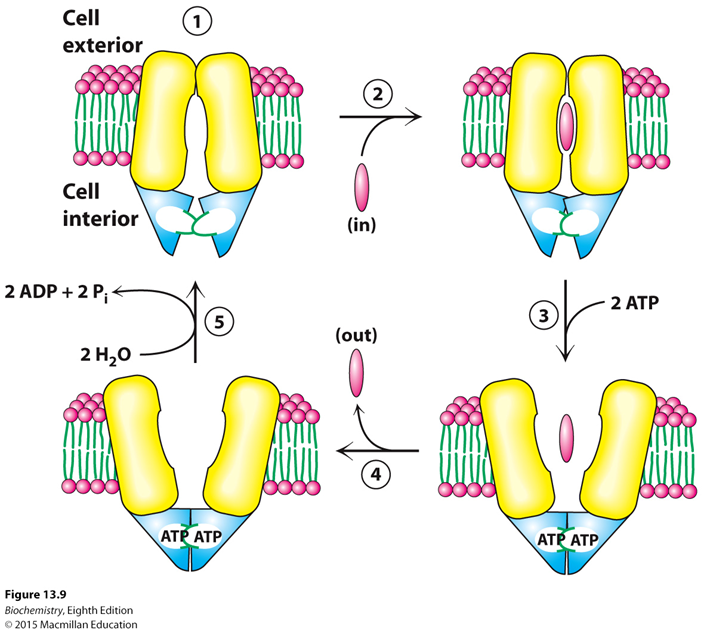
Methicillin-resistant Staphylococcus aureus (MRSA)
Multidrug-resistant Mycobacterium tuberculosis (MDR-TB)
What are antiporters? Give an example.
What are symporters? Give an example.
What are uniporters? Give an example.
Two different molecules, one goes in, the other goes out (opposite direction). Sodium/Calcium pump
Two different molecules, both go in or both go out (same direction). Sodium/Glucose transporter)
One molecule that can go in or out. Glucose transport (GLUT)
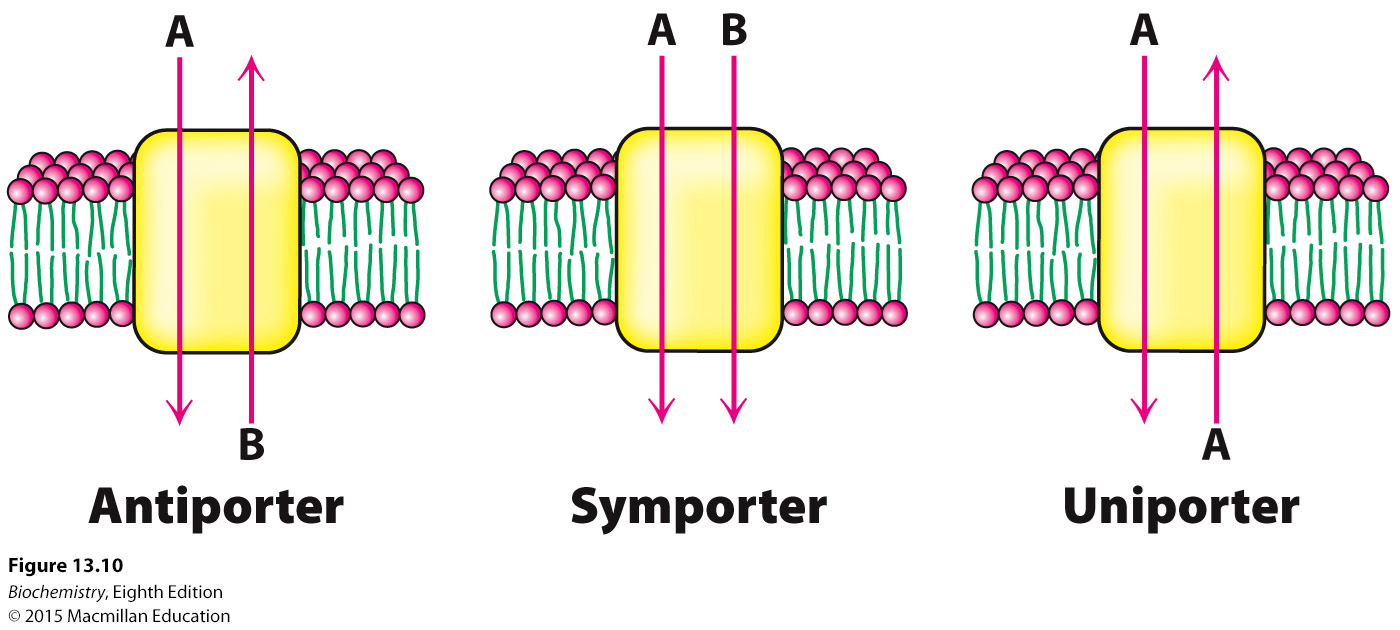
Why can a sodium channel be purified?
What facilitates this purification?
SABRINA! I’m confused on what this means and why it’s important (Slide 19 in Ch 13 focus)
It has an affinity for the neurotoxin tetrodotoxin
A mutated version of the potassium channel, termed shaker
If all of the pumps’ mechanisms are the exact same, how can they transport different ions?
What is potassium’s specific substrate?
What is calcium’s specific substrate?
What is sodium’s specific substrate?
Specificity: How channels are specific to its substrate
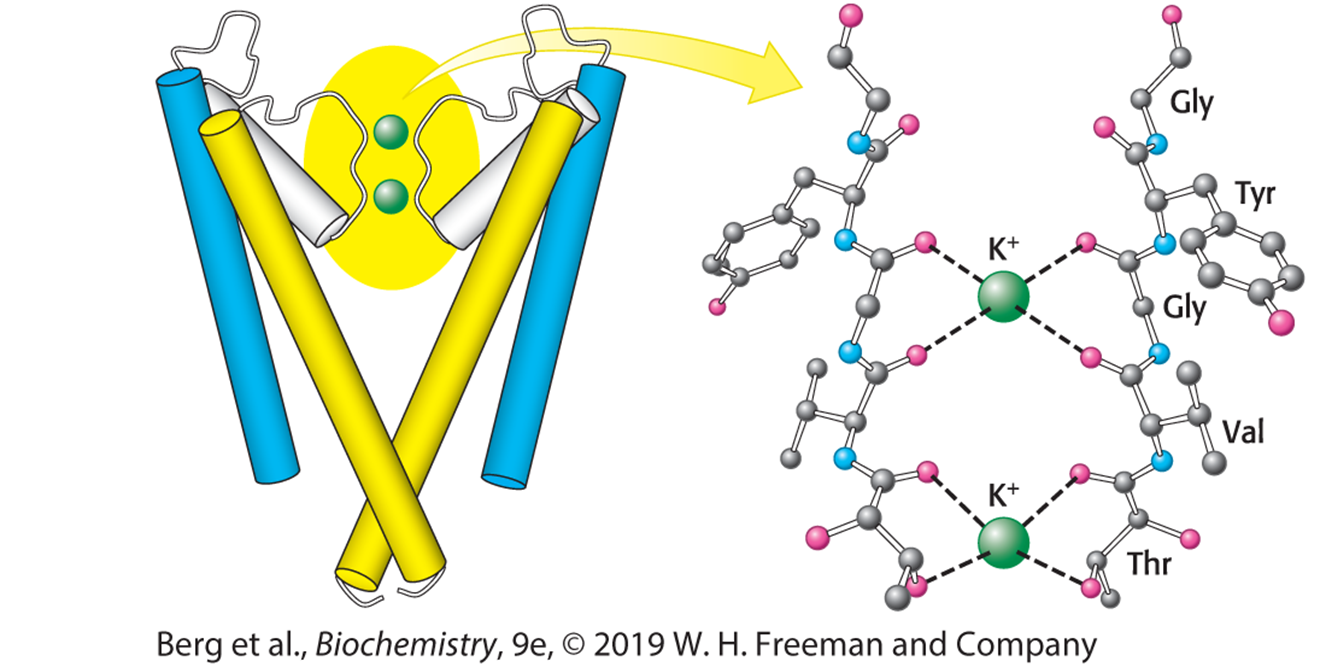
(Note: Potassium’s specific substrate is the TVGYG sequence of the electivity filter)
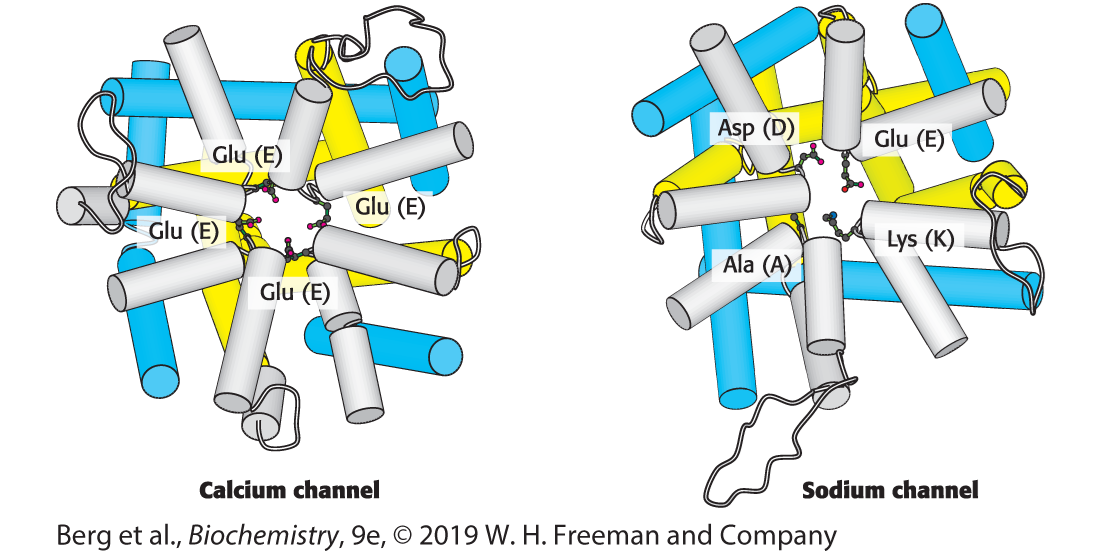
(Note: Calcium’s specific substrate is Glutamic acid)
(Note: Sodium’s specific substrate is DEKA)
How does acetylcholine trigger an action potential?
What is the acetylcholine receptor classified as?
The neurotransmitter gets released into the synaptic cleft, where it binds to a channel (acetylcholine receptor, a ligand-activated channel) and opens the channel to sodium and potassium
Sodium-potassium channel. When the ligand acetylcholine binds to the receptor, the channel opens and allows sodium potassium to enter the cell

(Note: Binding of acetylcholine causes conformational changes that rotate the membrane-spanning helices so that the pore opens to the passage of sodium and potassium ions)
What is Long QT syndrome (LQTS)?
What can this lead to?
What is the most common mutation identified?
A genetic disorder in which the recovery of the action potential from its peak potential to the resting equlibirium potential is delayed
Brief losses of consciousness (syncope), disruption of normal caridac rhythm (arrhythmia), and sudden death
Inactive potassium channels or prevention of the proper trafficking of these channels to the plasma membrane
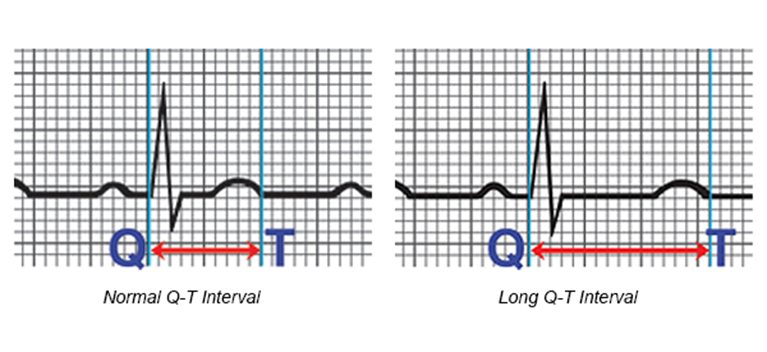
(Note: Graph represents the time it takes for the heart muscle to contract and then recover)
What are gap junctions and what do they generally allow?
What forms gap junctions? How many do these take to make a cell-to-cell junction?
What type of communication do gap junctions allow?
Cell-to-cell channels that allow passage of material between adjacent cells
Connexons from adjacent cells. 12
Cytoplasm-to-cytoplasm communication
